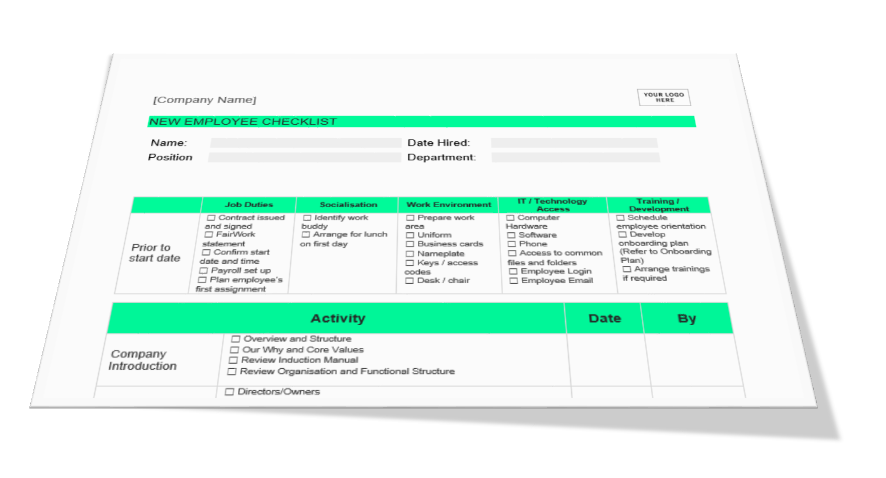Onboarding new employees
Onboarding a new employee into your business should be a smooth process for all involved. Onboarding is simply the process of a new employee starting with your business.
At first glance, onboarding seems like an easy, straightforward process. However it is very common for businesses to not get this step right. Let’s take a look at the actual process that should be followed when onboarding a new employee into your business.
The importance of hiring the right employees
Your business may be growing, or perhaps you’ve recently had to have a difficult conversation with an employee and let a team member go. Making sure that your new employee is a good fit for your team can have a big impact on the success of onboarding process.
It is important to make sure that when bringing a new employee into your team that they are a good cultural fit, and most importantly have the same values as your team. By successfully onboarding a new employee, it can help to position your business as an ‘employer of choice’.
What is the onboarding process for a new employee?
The onboarding process for a new employee starts before an employee’s first day with your business and extends up to the first 3-6 months of their employment. It includes a number of elements:
- The impression you and your business provide throughout the interview process
- your current team that a new team member will be starting, and also letting existing staff know when the new employee is starting, so that they can be made to feel welcome
- Making sure that a suitable desk and the necessary IT has been set-up so that they can hit the ground running
- Developing an onboarding plan
These first stages of an employee joining your business can greatly impact the perception of your business, how engaged your new employee is and their desire to stay in the long term. So set a realistic pace, provide a supportive environment and the connection between loyalty and performance should be reflected by your new recruit.
Developing an onboarding plan
As the business owner with lots of experience under your belt, it can be easy to forget what it was like to start as the new employee. Many people find this quite confronting, however as the owner you can make it even more difficult. Being the new kid on the block, who is left to ‘learn as they go’ with no structure or processes to follow, doesn’t make for a good experience.
This is where developing an onboarding plan becomes an important step in the onboarding process.
You should have a clearly documented onboarding plan, that someone within your team owns and ensures that all the necessary sessions and meetings are booked in and completed. This role is usually undertaken by the supervisor of the new employee, a HR or support person, or in some cases the business owner.
What is included in the onboarding plan?
The onboarding plan is a comprehensive document that should be personalise dependent on role requirements and the new staff members capability and experience. To get things started, consider the following suggestions for the early phase of the plan:
Onboarding Plan - Week 1
- A schedule of each day for the first week (including the key activities/meetings/sessions)
-
What the key sessions are
- Company overview
- Culture and values
- How the employee’s role fits into the business
- Overall business strategy
- Meeting key people within the business
- Meeting with HR and answering any questions
- Outline any training videos to be watched and/or key policies and procedures to be read
Onboarding Plan - Weeks 2 - 4
- Learning the systems/technology used within the business
- Getting hands on training on processes relevant to the role
- Training and observation completing the role requirements
- Revisiting goals and responsibilities of the role and any KPIs
Development Plan
During the later stages of the onboarding process, it is recommended to complete a development discussion with the not-so-new employee. This allows for a really supportive and transparent conversation with the team member to show that you care about them and their career. It also gives you some insight on how you can support them on their career path.
Support
The onboarding plan should include a regular check in (initially weekly) which ensures that the supervisor/business owner meets with the team member for the first 2-3 months. This time together allows you to discuss their progress and answer any questions.
It is also recommended to ask another team member (who is at a similar role level) to be a support person for the new employee. This should be someone that the new employee can go to, to regularly ask questions in the early stages of their role.
New employee checklist
A new employee checklist is also a great way to keep track of the first stages of onboarding an employee, including the employee contract, relevant forms, IT to be set up etc. This forms an important part of the Onboarding Plan, and you can download a New Employee Checklist below.

Successfully onboarding new employees
The benefits of successfully onboarding new employees into your business can be felt for many years to come. By ensuring that your new employee feels supported and is integrated into the business as seamlessly as possible, you have a much higher rate of successfully keeping them as part of your team into the future. It also allows your new employee to become productive within their role as quickly as possible, without simply being thrown in the deep end.
Running a business can feel overwhelming, but it doesn’t
have to be.
Related Blogs

Rising to the challenge of change

Systemising Your Business - Greg Gunther ft. on Business Built Freedom Podcast
